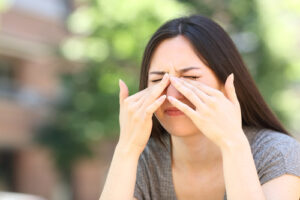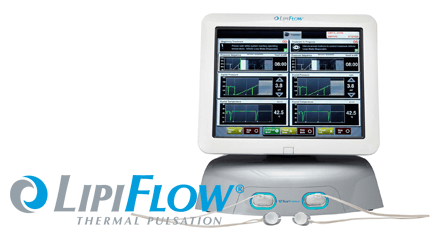Do you have itchy, irritated, or watery eyes? It may be due to allergies if you’re experiencing these symptoms.
Eye allergy symptoms, or allergic conjunctivitis, are prevalent, especially during allergy season. One of the most common allergies that cause allergic conjunctivitis is pollen.
Pollen is highly abundant in the air, on surfaces, and even in your home during the spring. But any allergen can trigger allergic conjunctivitis, especially if it’s airborne, like mold or dander.
Your eyes may not feel irritated due to allergies, however. Eye irritation that causes dryness may be due to dry eye syndrome.
Dry eyes is a chronic condition that occurs when your eyes don’t produce tears correctly. Tears keep your eyes healthy, so they can feel uncomfortable without them.
But how do you know if your eyes are irritated due to allergies or dry eye syndrome? The only way to know for sure is to see an eye care professional at St. Luke’s Cataract & Laser Institute to receive a diagnosis.
However, the symptoms of each condition differ slightly, so you may want to get a good idea of what’s causing your symptoms before seeing an eye doctor. Keep reading to learn if your symptoms could be due to allergies or dry eyes!
Allergic Conjunctivitis

Allergic conjunctivitis refers to the inflammation of the conjunctiva. The conjunctiva is the membrane that covers the eye and the inside of the eyelids.
Inflammation can occur if you experience exposure to an allergen. The allergen triggers an immune response, which can cause several symptoms.
Inflammation can make your eyes water, overproduce mucus, and appear red and puffy. But the primary symptom of allergic conjunctivitis is itching.
If you are experiencing intense itching from allergic conjunctivitis, you may have the urge to run your eyes to relieve this itch. You shouldn’t, as rubbing your eyes only makes the symptoms worse.
It can also expose your eyes to more allergens on your fingers or hands.
Allergy medication can help relieve your symptoms, along with home remedies like a cool, wet compress, but in severe cases, professional treatment may be required.
Dry Eye Syndrome

Dry eye syndrome is a chronic condition that occurs when your eyes are dry. Many patients develop dry eye syndrome due to producing too few tears, or the tears produced are low in quality and cannot provide sufficient nutrients to the eyes.
Anyone can get dry eyes occasionally from dry weather, their environment, dehydration, and other temporary factors, but dry eye syndrome occurs when the symptoms are persistent. Dry eye syndrome is more common in older patients and women, especially women undergoing hormonal changes.
Dry eye syndrome often causes or is caused by inflammation. But unlike allergic conjunctivitis, the primary symptom isn’t itching. Instead, patients with dry eye syndrome experience burning, stinging, and the feeling of grit in the eye.
Diagnosis
Understanding the differences between allergies and dry eye syndrome makes diagnosing dry eyes easier. If you think you have dry eye syndrome, the first step is to see your eye doctor.
If you have mild allergies, a good place to start is by taking over-the-counter antihistamines. But if over-the-counter options for allergy medication don’t work, it’s time to schedule an eye examination.
You may have dry eye syndrome,several allergies based, or you may have both at the same time. Both conditions can lead to severe irritation, making it even more challenging to differentiate between symptoms and their root cause.
When you see a team member at St. Luke’s, we will start by testing you for allergies with a skin test. A skin test will help determine which allergens trigger an allergic response, what you’re allergic to, and the severity of your allergies.
We can also test the composition of your tears, which can help determine if you have dry eye syndrome. Both tests will help us understand if you have a combination of dry eye syndrome and allergies. After receiving a diagnosis, we can recommend the best treatment to treat your symptoms at their root.
Treatment
There are a variety of treatments for dry eye syndrome, and many of these are non-invasive. Your eye doctor may start by recommending you make small lifestyle changes like keeping a humidifier at home, adding more omega-3 fatty acids to your diet, and using an eyelid scrub to keep your eyes clean.
These simple changes often alleviate many patients’ dry eye symptoms. But your eye doctor at St. Luke’s can also offer prescriptions and other treatments if home remedies don’t work.
Restasis and Xiidra
We offer prescription eye drops like Restasis and Xiidra to patients that need help increasing their eye’s natural ability to produce tears. These drops can also help reduce inflammation, helping you remain more comfortable.
BlephEx
For patients with blepharitis, commonly associated with dry eye syndrome, we offer a treatment called BlephEx. BlephEx helps remove inflammatory debris on the lids and eyelashes while improving dry eye symptoms.
Prokera and Bio D Optix
If patients with more severe dry eye symptoms have not responded to other treatments, we may recommend amniotic membrane treatments like Prokera and Bio D Optix. These treatments use an amniotic membrane placed on the eye for a few days to lower inflammation and aid in the overall hydration of the eye.
Lipiflow

One of the most effective treatments for dry eye syndrome offered at St. Luke’s is Lipiflow. Lipiflow is a dry eye therapy performed in-office.
It uses gentle light and heat to soften the oil glands in the eye. When these oil glands, called meibomian glands, get blocked, your tears lack a protective coating of oil, causing them to evaporate too quickly from the surface of the eye.
This is called meibomian gland dysfunction. Lipiflow treats meibomian gland dysfunction by allowing the oils to flow freely.
Immunotherapy Sublingual Drops

We also offer treatment options for allergic conjunctivitis patients that don’t respond to over-the-counter medication. At St. Luke’s, your optometrist or ophthalmologist may recommend sublingual immunotherapy drops.
You place these drops under your tongue to help build up your allergy resistance and reduce your symptoms’ severity, allowing them to respond better to antihistamines.
Are you tired of living with burning, stinging, itchy, inflamed, or irritated eyes? Schedule your appointment at St. Luke’s Cataract & Laser Institute at one of our seven locations to get the relief you need!








